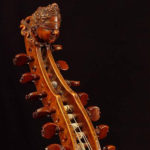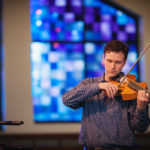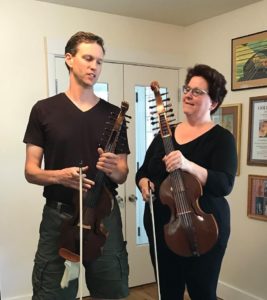That’s D’amore! with Colorado Chamber Players
 The viola d’amore may be the white tiger of the fine music world: remarkably beautiful, but startlingly rare. Even those who are well familiar with the standard variety may have never seen and heard one in person – let alone two of them at once. That one of those two players will bring an extra instrument, for the sake of contrasting a vintage instrument to a recently commissioned one, adds further to this October’s exploration of all things d’amore thanks to the Colorado Chamber Players.
The viola d’amore may be the white tiger of the fine music world: remarkably beautiful, but startlingly rare. Even those who are well familiar with the standard variety may have never seen and heard one in person – let alone two of them at once. That one of those two players will bring an extra instrument, for the sake of contrasting a vintage instrument to a recently commissioned one, adds further to this October’s exploration of all things d’amore thanks to the Colorado Chamber Players.In the hands of just the right players – and, for that matter, just the right composers – the viola d’amore adds a distinctive flavor to music. Those right composer hands included the mighty JS Bach, as well as Telemann and Vivaldi, and though one can play their d’amore parts on a standard viola, one ought to remember that the result will not quite be what the composer had originally imagined. Whether in a solo role – both Telemann and Vivaldi wrote notable concerti for the instrument – or as supporting colors for a vocal piece of tender or poignant mood, as Bach tended to use it, the viola d’amore is something special indeed.
Matthew Dane, one of the two viola d’amore soloists for the upcoming Colorado Chamber Players concert, says he added the instrument to his toolbox so as to “come to know Baroque music in a different way.” He possesses two violas d’amore: a 1731 instrument by Eberle exactly of the type that Bach and Company would have known, and a newly commissioned one from 2013. Dane observes that the two, though largely similar in design, yet “sound amazingly different,” and he looks forward to sharing those dissimilar voices with the audience.
Barbara Hamilton, who will also be playing viola d’amore at the Colorado Chamber Players concert, recalls that she was attending the Tafelmusik Festival in Toronto in 2016 and happened to stroll into a workshop on the viola d’amore. The presenter, Thomas Georgi, handed her his personal Eberle viola d’amore and invited her to give it a try. Declaring it to be “one of the most beautiful sounding instruments I’ve ever heard or played,” Hamilton began to research the instrument’s idiosyncrasies, notably that it has seven or eight standard tuning systems, each requiring different fingerings, and that composers may or may not have bothered to specify which tuning will work best with which work.
The two violists d’amore will be joined by Ann Marie Morgan (viola da gamba and cello piccolo), Eric Wicks (harpsichord) and Daniel Hutchings (tenor) for selections from JS Bach’s Cantata no. 36 and his St. Matthew Passion, as well as a Partita from Harmonia Artificioso by Bach’s elder contemporary, Salzburg-based Heinrich Franz von Biber. The program also includes an anonymous trio for two violas d’amore and continuo from the Rostock archive, as well as Malor me bat (2004), a 21st century duo for viola d’amore and cello by Garth Knox, a European-based composer who draws upon his own experience as a performer on the viola d’amore to give the instrument a new place in the spotlight.
The Colorado Chamber Players “That’s d’Amore” program will be Sunday, October 21, at 2pm at Broomfield Auditorium, 3 Community Park Road in Broomfield, just off Wadsworth and US 36/Boulder Turnpike. The program will be repeated Wednesday Oct. 24, at 7:30 pm at Denver’s McNichols Civic Center Building (across Bannock from the City and County Building), 3rd Floor. Tickets and further details are available through the ensemble’s website:
Is there a future for this slightly antique instrument? Dane, Hamilton, and the Colorado Chamber Players certainly hope so. Not only are they eagerly anticipating the upcoming performance, but they also seek to expand attention for the instrument in general. Dane has been actively commissioning new repertoire for the viola d’amore, seeking out especially composers with “an interest in world music [recall the instrument’s exotic roots], and also are adventurous in trying new things.” He finds that what works best is to sit down with those composers, his d’amore in hand, to give them first-hand exposure to what it can do. Audiences, too, are encouraged to gain that exposure, and Denver-area listeners will have a chance October 21st and 24th. Hamilton says that playing the viola d’amore one can “feel the vibrations of the resonating strings in your body, and the spiritual rewards are abundant.” We listeners may not feel the vibrations, but the spiritual rewards are still there. Moreover, if it was good enough for JS Bach and Biber, surely it’s worthy of our attention, too!














